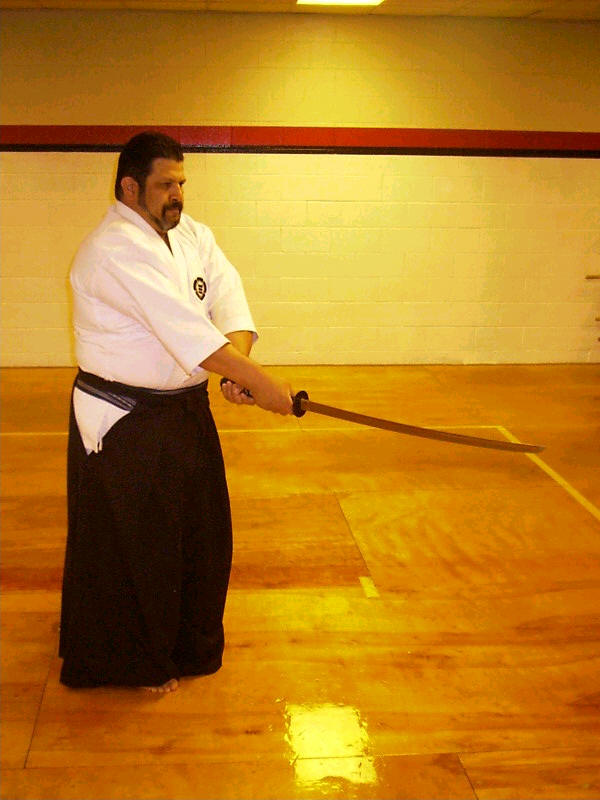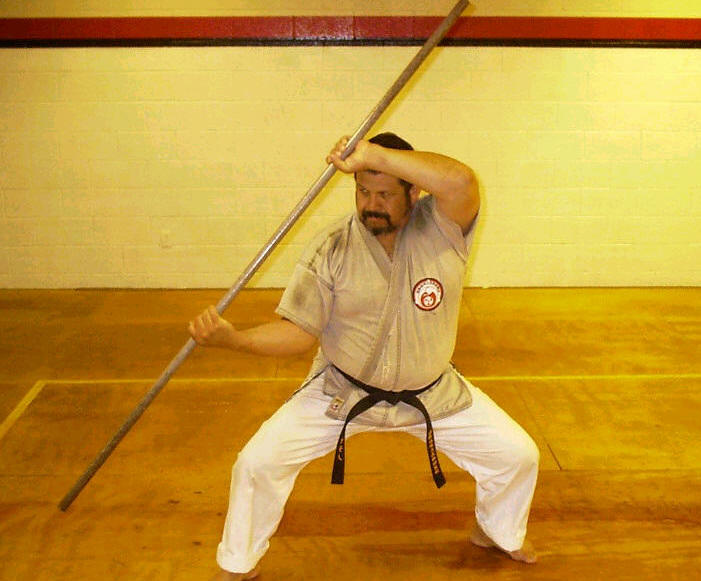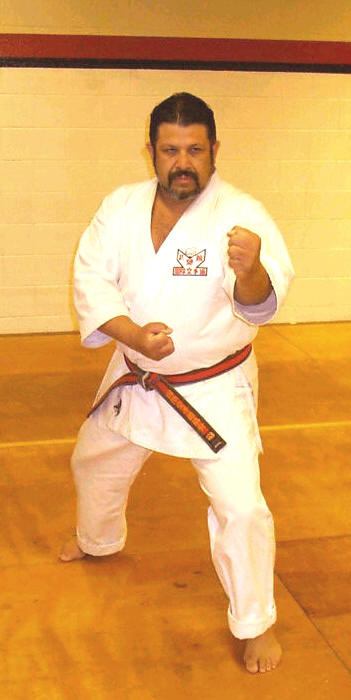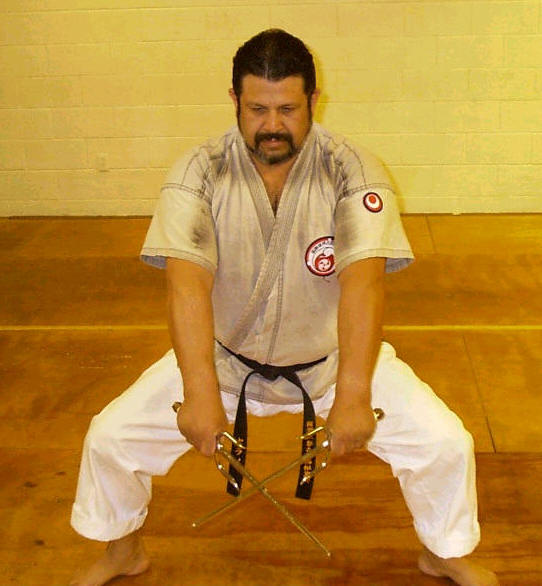 Sensei Jeff Learned
Sensei Jeff Learned
Copyright 2005
 Sensei Jeff Learned
Sensei Jeff Learned
There has always been a great deal of debate about which type of competition best suits a Japanese style martial artist—traditional or open. Many Japanese style karate ka think that traditional tournaments are superior because they are better able to compare and judge each other’s skill levels by staying within a similar set of concepts and techniques. Others argue that open competition is better since competitors are forced to confront and compete against any and all types of martial artists and thus it gives them a wider (and perhaps more realistic) range of experience. Tom Serrano, a sixth degree black belt in Tak Kubota’s IKA and a long time competitor in both open and traditional tournaments, has a slightly different viewpoint about this debate; it concerns the practicality of the training for each of these kinds of competition.
Walking into Tom Serrano’s dojo in Pasadena was like going home for any practitioner of Japanese karate. There were all sorts of people dressed in traditional white karate gi wearing a variety of colored belts and most of them were sweating from their workout. In between formal classes some students would learn a new kata or polish one they already knew, while others sparred in a good natured but serious manner. Kiai was an often-heard punctuation to a strong attack or counter.

During one of these moments I once saw two men sparring in the middle of the floor while Tom Serrano, former AAKF national kata champ, watched them closely. At one point the bigger of the two fighters snapped out a quick jab to his opponent’s face. At the same moment the smaller man attacked to the stomach with a reverse punch. Both techniques touched at about the same time with the bigger man’s being just a breath faster. Serrano moved his hand back and forth and called out clearly, “No point.”

To many onlookers it may have looked like one or the other deserved a point, but it is hard to argue with Serrano’s experience and judgment. The two continued to spar for a few more minutes with neither one gaining any clear advantage.
Serrano commented on how that one exchange was the key difference between open and traditional competition styles. In an open tournament the bigger student would have likely been awarded a point, but in a traditional match either no one would have gotten a point or the smaller man would have been awarded it. So why the difference of opinion in something that should be basically black and white?

“Open competition tends to focus on who gets the punch in first,” says Serrano. “It doesn’t matter if the attacker is on balance or if it’s a strong punch; it just matters that he hits first.” And while there is something to be said for having a fast punch, if the person throwing it isn’t on balance or does not have the potential for delivering an effective blow then it should not be considered effective. Serrano noted that the bigger man from the match in the dojo had leaned forward in order to reach his opponent; therefore Serrano didn’t give him the point.
“A lot of big guys can hit with devastating force even if they’re throwing from the shoulder or leaning forward to get the reach, but what if they miss?” Serrano points out. “Their balance will be entirely off and they can’t recover fast enough to protect themselves or do a follow up technique.” He mentions one tournament where a contestant was running away from his opponent during a match. As he ran he threw a back fist over his shoulder and scored a point--just before he was run over by his opponent. The match may have gone to him but it was clear who won the fight. Obviously not all matches are like this, but more and more practitioners feel they are becoming common.
Traditional style competition, on the other hand, concentrates more on the proper execution of techniques. In order to score a point the competitor must be the correct distance from his opponent, maintain good form, and be on target. If all three of these criteria are not met there is no chance of a point being scored. And, of course, the attack has to be completed before the other opponent can respond. That was why Serrano didn’t give the smaller man from the dojo a point. His form, distance, and targeting were fine, but his timing was off. “After all,” Serrano states, “the other guy did get his punch in, even if he didn’t have proper form.”
Open competitions seem less concerned with the proper form of a technique than traditional ones. Judges in traditional tournaments look for correct solid stances and power that comes from the hips instead of the shoulders. “That’s just one practical aspect of good form,” comments Serrano. “Only big strong people can develop a strong punch using shoulder muscles, but almost anyone can make a good punch when the hips and lower body generates the power.” Therefore the form of the technique helps to illustrate its overall effectiveness. If this element is not taken into account the true result of the attack remains in question.

Balance is another aspect of proper form that traditional competition requires of its practitioners. When an attack is delivered the attacker must maintain his balance in order to be able to respond to a counter or to continue his attack. If he is off balance or leaning forward he has to recover from his attack before he can do anything else. That takes time. During that time the opponent can counter with an attack of his own and end up winning the fight. Leaning, especially leaning forward, is a common example of improper balance that many competitors use to gain distance. Serrano remembers a tournament where one competitor leaned in to deliver a jab to the face and ended up bringing his own face right into his opponent’s punch. “It was quite a mess, let me tell you,” says Serrano. “You don’t get your distance by leaning; you get it from the proper execution of your technique. Anything else is dangerous. Unfortunately, open competitions don’t seem to be interested in that.”
There are problems with traditional style tournaments as well. Some traditional styles require that competitors hold their punches out to show correct focus or targeting. Others have restrictions on techniques like sweeps or throws. Holding a punch out rather than retracting it quickly is clearly not realistic as far as a real fight goes, but it does help to better judge the overall form and control. Serrano feels that if a person is not in control of his technique then mistakes can occur and the price for these mistakes can be enormous. Ultimately, he would rather err on the side of proper execution rather than the faster punch.
“Some people seem to think that if you do a technique correctly then it can’t be fast,” laughs Serrano. “That it is better to throw yourself into the movement and give up your balance in order to have a faster delivery time. That just isn’t so.” He points out that if a technique is done correctly it is just as fast, if not faster, than one that does not maintain its form. He remembers watching a super eight film of Ben Otake demonstrating a proper oizuki, stepping punch. It was so fast that all they could see was a blur. It turns out that it took only three frames from start to finish to complete the step and punch. That works out to be about one eighth of a second. “That seems pretty fast to me,” chuckles Serrano.
The overall debate between open and traditional competition is reminiscent of the
debate over western and Japanese fencing. In a contest which type would prevail?
When the contest was finally held the western fencer invariably touched the kendo ka
with his foil before the shinai struck the fencer. When asked about this defeat, one
kendo ka just shrugged. He pointed out that while his opponent had indeed touched
him first, only once in his ten matches was the location of the thrust a fatal one, and
even that one would not have kept him from finishing his cut. All of his strikes would
have been fatal.
Karate is a martial art. All the techniques and training that go into learning this art should
be based in reality and have practical applications. Competition has its place in the
martial arts world, but when the techniques or training methods practiced are designed to
win a tournament regardless of their effectiveness then perhaps it is time to step back and
reevaluate. As Serrano says, “I teach people karate. I would rather have someone learn it
properly and lose in a competition than learn it improperly and lose in a fight.”
Jeff Learned has over 35 years of martial arts training. He has been a direct student of Ben Otake since 1978 and is now one of his assistant instructors. Encouraged by Otake, he has studied other forms of martial arts and is currently a 5th degree black belt in karate, a 4th degree black belt in iaido (Japanese sword), and a 1st degree in judo. In addition to practicing marital arts, Learned has produced several karate and iaido videos featuring sensei Ben Otake and Masakazu Tazaki.